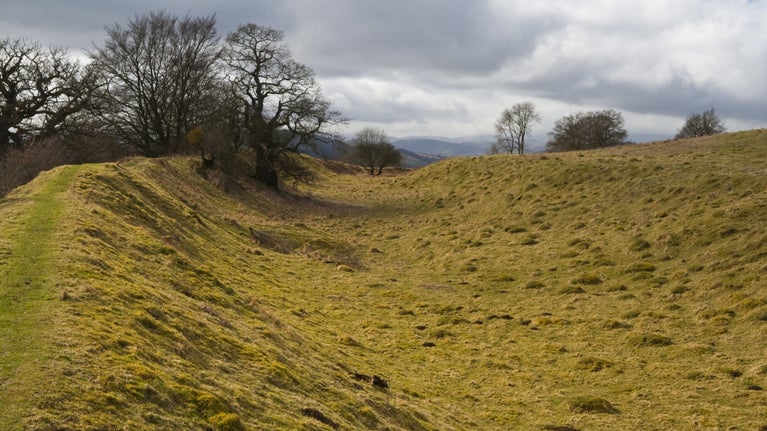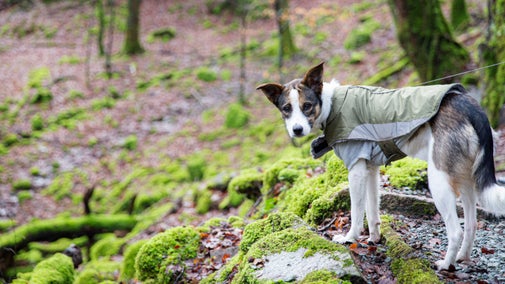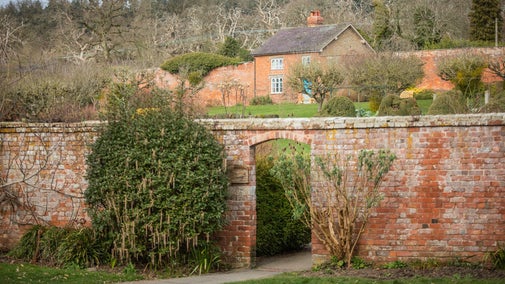
Discover more at Croft Castle and Parkland
Find out when Croft Castle is open, how to get here, things to see and do and more.

Croft has 1,500 acres of woodland, farmland and parkland and is home to a wealth of ancient trees, 'Picturesque' Fishpool Valley, archaeology and an Iron Age hillfort, all just waiting to be discovered.
There are five waymarked walks to choose from at Croft Castle where you can fully immerse yourself in the majesty of the ancient trees and the breath-taking views across the Herefordshire countryside. Throughout the parkland you'll find ancient trees, an Iron Age hillfort, woodland, orchard, a SSSI river and much more.
A long woodland walk taking in the River Lugg. A Site of Special Scientific Interest with some ancient trees and the old bridge that was part of the original approach to the castle.
A ramble through fields and woodland, a circuit of Croft Ambrey Iron Age hillfort, then back to your starting point via the outskirts of the picturesque Fishpool Valley.
An enjoyable stroll through the fields around Croft Castle, taking in some of the ancient trees on the estate, including an avenue of chestnuts and the 1,000-year-old Quarry Oak. There's also a chance to visit the medieval church of St Michaels and All Angels.
Discover the beautiful Fishpool Valley, landscaped during the late 18th century in the naturalistic ‘Picturesque’ style. This pleasant walk takes in the chain of dams and pools, carefully planted trees and architecture such as the icehouse, grotto, pumphouse and limekiln.
Explore the restored historic paths and woodland of Fishpool Valley, landscaped during the late 18th century. Climb to the highest point in the valley for views over the series of dams and pools and visit the remains of the summerhouse, icehouse and Gothic pumphouse.
An overview map showing all of the walks is available.

Croft’s parkland is teeming with wildlife all year round. Fallow deer, first introduced by the Normans in the 11th century, still call Croft their home with the original deer-park boundary running along the northern edge of the car park.
Although in drastic decline as a species, the British native white-clawed crayfish can be found in the water, among fallen leaves and submerged logs in Fishpool Valley. Dormice, otters and bats are also sighted in the valley.
Fallen deadwood is a valuable habitat, a home to woodlice, beetles and countless other creatures. Standing deadwood is even better. Even after death trees survive as monoliths, a host to myriad plants and animals, and a roost for birds and bats.
Croft is also a busy place for bird life where you might see tawny owls, robins, finches, chaffinches, woodpeckers, nuthatches and siskins at different times of year.
Croft's parkland is transformed by carpets of bluebells in April and May. You’ll notice smatterings of bluebells in and around the trees along the entrance drive, but the biggest blankets of blue are to be found in the wood pasture. There are thousands underneath the Candelabra Oak, which is the perfect spot to get lost in your thoughts and listen to the birds.
There is intriguing folklore surrounding bluebells. Some believed that by wearing a wreath made of the flowers, the wearer would be forced to tell the truth. Others believed that if you could turn one of the flowers inside out without tearing it, you would eventually find the one you love.
British bluebells will flower at the end of April (weather depending) and will flower until late May.

Croft has an impressive collection of ancient trees. There's the Quarry Oak at around 1,000 years old, the newly discovered Candelabra Oak at around 750 years old and the Herefordshire county champion Douglas Fir in Fishpool Valley which stands at 57.6 metres in height.
One particularly special tree is the Quarry Oak which was just starting its life when William the Conqueror invaded Britain. It’s remarkable to think of all that has happened in the world during the life of this tree, and that for centuries it provided the estate with valuable firewood and building material from its crown.
The Candelabra Oak is so named because of its outline. With a nine-metre girth, the Candelabra Oak is thought to be around 900 years old which means this tree would’ve been a youngster when the Magna Carta was signed in 1215.
Its shape is as a result of its being pollarded for many years until relatively recently, to provide firewood for the estate. Pollarding and coppicing are ways in which trees can be made to live longer than when allowed to grow freely.
Near the Castle is the Spanish chestnut avenue which was the original formal approach to the Castle. Aerial views of the avenue show lines and clumps of these trees which could represent a battle. It is said that chestnuts were gathered from a shipwrecked Spanish galleon and were planted in the formation of the Spanish fleet.
In the neighbouring meadow there’s a fine collection of ancient English oaks which were reputedly planted in the formation of the British fleet, all done to commemorate the victory over the Spanish.

Find out when Croft Castle is open, how to get here, things to see and do and more.
Click here for a PDF version of the Croft Castle walks map. All walks and trail routes can be found in the 'Things to see and do' section of our website.

Croft Castle is a two pawprint rated place. You and your dog can explore 1,500 acres of parkland and beautiful gardens at Croft Castle.

Find out how the Croft family played their part in major historical events, and how Croft Castle eventually passed to the National Trust.

Croft Castle was noted in the Domesday book in 1086 and the Croft family have played a part influencing British political and military history ever since. Uncover their stories in the castle.

Discover the garden at Croft Castle, taking in the historic orchard within the walled garden, or listen to the birds in the church garden.

Tuck into some lunch and light bites in the Carpenter’s tea-room at Croft Castle, or visit the second-hand bookshop to find yourself a pre-loved classic.

Plan a visit to one of the special countryside places in our care and discover the benefits of being in the great outdoors. Pack your walking boots and get ready to explore woodlands, valleys and rivers.

Take a walk through the stunning countryside in Herefordshire and Worcestershire, past lakes and rivers, or enjoy the views across the county and beyond this winter season.